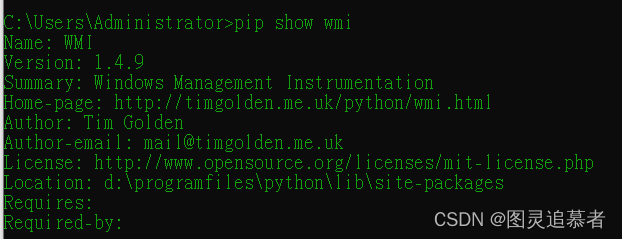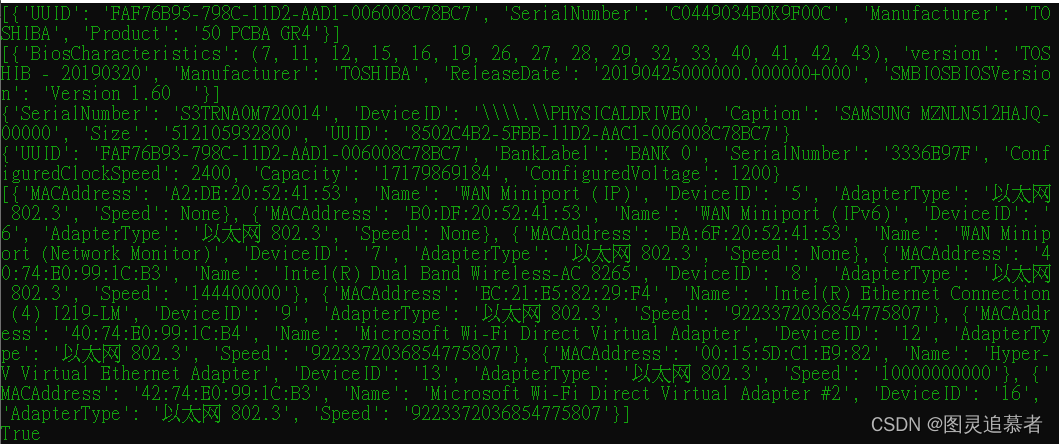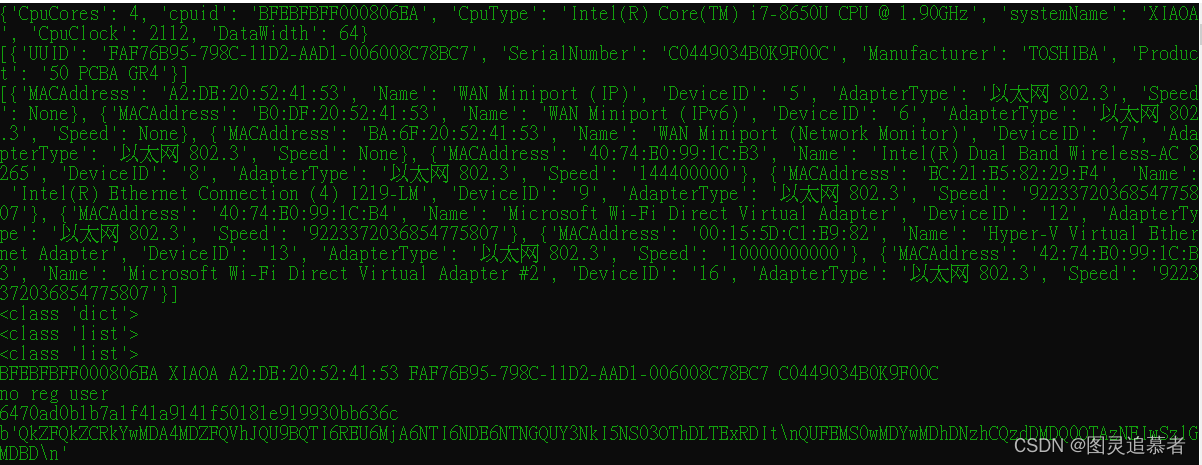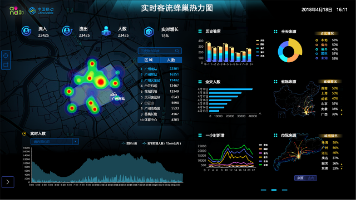基于python的电脑硬体设备信息获取
python获取电脑硬件详细信息。
·
功能:
使用python编程实现电脑硬体信息的获取,主要包括电脑的CPU信息、主板信息、硬盘信息、内存信息、BIOS信息、电池信息等。
环境:
python==3.6.8 wmi==1.4.9

代码:
#!/usr/bin/env python
# -*- coding: utf-8 -*-
import os, sys
import wmi
c = wmi.WMI()
#处理器
def printCPU():
tmpdict = {}
tmpdict["CpuCores"] = 0
for cpu in c.Win32_Processor():
tmpdict["cpuid"] = cpu.ProcessorId.strip()
tmpdict["CpuType"] = cpu.Name
tmpdict['systemName'] = cpu.SystemName
try:
tmpdict["CpuCores"] = cpu.NumberOfCores
except:
tmpdict["CpuCores"] += 1
tmpdict["CpuClock"] = cpu.MaxClockSpeed
tmpdict['DataWidth'] = cpu.DataWidth
print (tmpdict)
return (tmpdict)
#主板
def printMain_board():
boards = []
# print len(c.Win32_BaseBoard()):
for board_id in c.Win32_BaseBoard():
tmpmsg = {}
tmpmsg['UUID'] = board_id.qualifiers['UUID'][1:-1] #主板UUID,有的主板这部分信息取到为空值,ffffff-ffffff这样的
tmpmsg['SerialNumber'] = board_id.SerialNumber #主板序列号
tmpmsg['Manufacturer'] = board_id.Manufacturer #主板生产品牌厂家
tmpmsg['Product'] = board_id.Product #主板型号
boards.append(tmpmsg)
print (boards)
return (boards)
#BIOS
def printBIOS():
bioss = []
for bios_id in c.Win32_BIOS():
tmpmsg = {}
tmpmsg['BiosCharacteristics'] = bios_id.BiosCharacteristics #BIOS特征码
tmpmsg['version'] = bios_id.Version #BIOS版本
tmpmsg['Manufacturer'] = bios_id.Manufacturer.strip() #BIOS固件生产厂家
tmpmsg['ReleaseDate'] = bios_id.ReleaseDate #BIOS释放日期
tmpmsg['SMBIOSBIOSVersion'] = bios_id.SMBIOSBIOSVersion #系统管理规范版本
bioss.append(tmpmsg)
print (bioss)
return (bioss)
#硬盘
def printDisk():
disks = []
for disk in c.Win32_DiskDrive():
# print disk.__dict__
tmpmsg = {}
tmpmsg['SerialNumber'] = disk.SerialNumber.strip()
tmpmsg['DeviceID'] = disk.DeviceID
tmpmsg['Caption'] = disk.Caption
tmpmsg['Size'] = disk.Size
tmpmsg['UUID'] = disk.qualifiers['UUID'][1:-1]
disks.append(tmpmsg)
for d in disks:
print (d)
return (disks)
#内存
def printPhysicalMemory():
memorys = []
for mem in c.Win32_PhysicalMemory():
tmpmsg = {}
tmpmsg['UUID'] = mem.qualifiers['UUID'][1:-1]
tmpmsg['BankLabel'] = mem.BankLabel
tmpmsg['SerialNumber'] = mem.SerialNumber.strip()
tmpmsg['ConfiguredClockSpeed'] = mem.ConfiguredClockSpeed
tmpmsg['Capacity'] = mem.Capacity
tmpmsg['ConfiguredVoltage'] = mem.ConfiguredVoltage
memorys.append(tmpmsg)
for m in memorys:
print (m)
return (memorys)
#电池信息,只有笔记本才会有电池选项
def printBattery():
isBatterys = False
for b in c.Win32_Battery():
isBatterys = True
return (isBatterys)
#网卡mac地址:
def printMacAddress():
macs = []
for n in c.Win32_NetworkAdapter():
mactmp = n.MACAddress
if mactmp and len(mactmp.strip()) > 5:
tmpmsg = {}
tmpmsg['MACAddress'] = n.MACAddress
tmpmsg['Name'] = n.Name
tmpmsg['DeviceID'] = n.DeviceID
tmpmsg['AdapterType'] = n.AdapterType
tmpmsg['Speed'] = n.Speed
macs.append(tmpmsg)
print (macs)
return (macs)
def main():
printCPU()
printMain_board()
printBIOS()
printDisk()
printPhysicalMemory()
printMacAddress()
print (printBattery())
if __name__ == '__main__':
main()
结果:

适当的对上面代码改进,可以增加加密功能,并将密码写入到一个xml文件中。
import os, sys
import wmi
import hashlib
import base64
c = wmi.WMI()
#处理器
def printCPU():
tmpdict = {}
tmpdict["CpuCores"] = 0
for cpu in c.Win32_Processor():
tmpdict["cpuid"] = cpu.ProcessorId.strip()
tmpdict["CpuType"] = cpu.Name
tmpdict['systemName'] = cpu.SystemName
try:
tmpdict["CpuCores"] = cpu.NumberOfCores
except:
tmpdict["CpuCores"] += 1
tmpdict["CpuClock"] = cpu.MaxClockSpeed
tmpdict['DataWidth'] = cpu.DataWidth
print (tmpdict)
return tmpdict
#主板
def printMain_board():
boards = []
# print len(c.Win32_BaseBoard()):
for board_id in c.Win32_BaseBoard():
tmpmsg = {}
tmpmsg['UUID'] = board_id.qualifiers['UUID'][1:-1] #主板UUID,有的主板这部分信息取到为空值,ffffff-ffffff这样的
tmpmsg['SerialNumber'] = board_id.SerialNumber #主板序列号
tmpmsg['Manufacturer'] = board_id.Manufacturer #主板生产品牌厂家
tmpmsg['Product'] = board_id.Product #主板型号
boards.append(tmpmsg)
print (boards)
return boards
#BIOS
def printBIOS():
bioss = []
for bios_id in c.Win32_BIOS():
tmpmsg = {}
tmpmsg['BiosCharacteristics'] = bios_id.BiosCharacteristics #BIOS特征码
tmpmsg['version'] = bios_id.Version #BIOS版本
tmpmsg['Manufacturer'] = bios_id.Manufacturer.strip() #BIOS固件生产厂家
tmpmsg['ReleaseDate'] = bios_id.ReleaseDate #BIOS释放日期
tmpmsg['SMBIOSBIOSVersion'] = bios_id.SMBIOSBIOSVersion #系统管理规范版本
bioss.append(tmpmsg)
print (bioss)
return bioss
#硬盘
def printDisk():
disks = []
for disk in c.Win32_DiskDrive():
# print disk.__dict__
tmpmsg = {}
tmpmsg['SerialNumber'] = disk.SerialNumber.strip()
tmpmsg['DeviceID'] = disk.DeviceID
tmpmsg['Caption'] = disk.Caption
tmpmsg['Size'] = disk.Size
tmpmsg['UUID'] = disk.qualifiers['UUID'][1:-1]
disks.append(tmpmsg)
for d in disks:
print (d)
return disks
#电池信息,只有笔记本才会有电池选项
def printBattery():
isBatterys = False
for b in c.Win32_Battery():
isBatterys = True
return isBatterys
#网卡mac地址:
def printMacAddress():
macs = []
for n in c.Win32_NetworkAdapter():
mactmp = n.MACAddress
if mactmp and len(mactmp.strip()) > 5:
tmpmsg = {}
tmpmsg['MACAddress'] = n.MACAddress
tmpmsg['Name'] = n.Name
tmpmsg['DeviceID'] = n.DeviceID
tmpmsg['AdapterType'] = n.AdapterType
tmpmsg['Speed'] = n.Speed
macs.append(tmpmsg)
print (macs)
return macs
if __name__ == '__main__':
hd1=printCPU()
hd3=printMain_board()
#printBIOS()
#printDisk()
hd2=printMacAddress()
print(type(hd1))
print(type(hd2))
print(type(hd3))
print(hd1['cpuid'],hd1['systemName'],hd2[0]['MACAddress'],hd3[0]['UUID'],hd3[0]['SerialNumber'])
sum = hd1['cpuid'] + hd1['systemName'] + hd2[0]['MACAddress'] + hd3[0]['UUID']+ hd3[0]['SerialNumber']
shastr = sum.encode('gbk')
sha = hashlib.sha1(shastr).hexdigest()
if (sha == 'b696fcbb46e27a09458019942dd10856b0023fea'):
print('reg user')
else:
print('no reg user')
print(sha)
#print(sum)
#print(type(sum))
s1 = base64.encodestring(shastr)
print(s1)
#s2 = base64.decodestring(s1)
#print(s1,s2)
#print (printBattery())
xmlfilename = 'result.xml'
f = open(xmlfilename, 'w') # 若是'wb'就表示写二进制文件
f.write(sha)
f.close()结果:

xml的结果:

更多推荐
 已为社区贡献38条内容
已为社区贡献38条内容










所有评论(0)